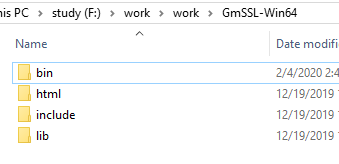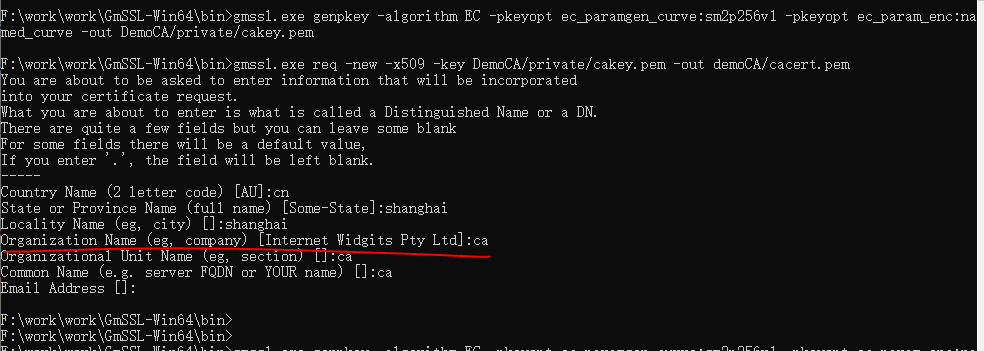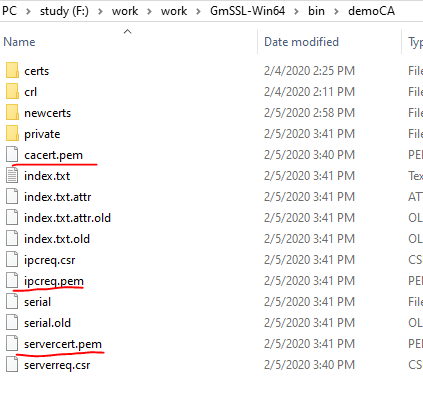环境准备: 1. GMSSL可以执行程序
如果木有,自行前往下载 http://gmssl.org/
编译可以参考前篇 编译https://www.cnblogs.com/leehm/p/12066683.html
2. openssl.cnf ------openssl自带
# # OpenSSL example configuration file. # This is mostly being used for generation of certificate requests. # # This definition stops the following lines choking if HOME isn't # defined. HOME = . RANDFILE = $ENV::HOME/.rnd # Extra OBJECT IDENTIFIER info: #oid_file = $ENV::HOME/.oid oid_section = new_oids # To use this configuration file with the "-extfile" option of the # "openssl x509" utility, name here the section containing the # X.509v3 extensions to use: # extensions = # (Alternatively, use a configuration file that has only # X.509v3 extensions in its main [= default] section.) [ new_oids ] # We can add new OIDs in here for use by 'ca', 'req' and 'ts'. # Add a simple OID like this: # testoid1=1.2.3.4 # Or use config file substitution like this: # testoid2=${testoid1}.5.6 # Policies used by the TSA examples. tsa_policy1 = 1.2.3.4.1 tsa_policy2 = 1.2.3.4.5.6 tsa_policy3 = 1.2.3.4.5.7 #################################################################### [ ca ] default_ca = CA_default # The default ca section #################################################################### [ CA_default ] dir = ./demoCA # Where everything is kept certs = $dir/certs # Where the issued certs are kept crl_dir = $dir/crl # Where the issued crl are kept database = $dir/index.txt # database index file. #unique_subject = no # Set to 'no' to allow creation of # several ctificates with same subject. new_certs_dir = $dir/newcerts # default place for new certs. certificate = $dir/cacert.pem # The CA certificate serial = $dir/serial # The current serial number crlnumber = $dir/crlnumber # the current crl number # must be commented out to leave a V1 CRL crl = $dir/crl.pem # The current CRL private_key = $dir/private/cakey.pem# The private key RANDFILE = $dir/private/.rand # private random number file x509_extensions = usr_cert # The extentions to add to the cert # Comment out the following two lines for the "traditional" # (and highly broken) format. name_opt = ca_default # Subject Name options cert_opt = ca_default # Certificate field options # Extension copying option: use with caution. # copy_extensions = copy # Extensions to add to a CRL. Note: Netscape communicator chokes on V2 CRLs # so this is commented out by default to leave a V1 CRL. # crlnumber must also be commented out to leave a V1 CRL. # crl_extensions = crl_ext default_days = 365 # how long to certify for default_crl_days= 30 # how long before next CRL default_md = default # use public key default MD preserve = no # keep passed DN ordering # A few difference way of specifying how similar the request should look # For type CA, the listed attributes must be the same, and the optional # and supplied fields are just that :-) policy = policy_match # For the CA policy [ policy_match ] countryName = match stateOrProvinceName = match organizationName = match organizationalUnitName = optional commonName = supplied emailAddress = optional # For the 'anything' policy # At this point in time, you must list all acceptable 'object' # types. [ policy_anything ] countryName = optional stateOrProvinceName = optional localityName = optional organizationName = optional organizationalUnitName = optional commonName = supplied emailAddress = optional #################################################################### [ req ] default_bits = 2048 default_keyfile = privkey.pem distinguished_name = req_distinguished_name attributes = req_attributes x509_extensions = v3_ca # The extentions to add to the self signed cert # Passwords for private keys if not present they will be prompted for # input_password = secret # output_password = secret # This sets a mask for permitted string types. There are several options. # default: PrintableString, T61String, BMPString. # pkix : PrintableString, BMPString (PKIX recommendation before 2004) # utf8only: only UTF8Strings (PKIX recommendation after 2004). # nombstr : PrintableString, T61String (no BMPStrings or UTF8Strings). # MASK:XXXX a literal mask value. # WARNING: ancient versions of Netscape crash on BMPStrings or UTF8Strings. string_mask = utf8only # req_extensions = v3_req # The extensions to add to a certificate request [ req_distinguished_name ] countryName = Country Name (2 letter code) countryName_default = AU countryName_min = 2 countryName_max = 2 stateOrProvinceName = State or Province Name (full name) stateOrProvinceName_default = Some-State localityName = Locality Name (eg, city) 0.organizationName = Organization Name (eg, company) 0.organizationName_default = Internet Widgits Pty Ltd # we can do this but it is not needed normally :-) #1.organizationName = Second Organization Name (eg, company) #1.organizationName_default = World Wide Web Pty Ltd organizationalUnitName = Organizational Unit Name (eg, section) #organizationalUnitName_default = commonName = Common Name (e.g. server FQDN or YOUR name) commonName_max = 64 emailAddress = Email Address emailAddress_max = 64 # SET-ex3 = SET extension number 3 [ req_attributes ] challengePassword = A challenge password challengePassword_min = 4 challengePassword_max = 20 unstructuredName = An optional company name [ usr_cert ] # These extensions are added when 'ca' signs a request. # This goes against PKIX guidelines but some CAs do it and some software # requires this to avoid interpreting an end user certificate as a CA. basicConstraints=CA:FALSE # Here are some examples of the usage of nsCertType. If it is omitted # the certificate can be used for anything *except* object signing. # This is OK for an SSL server. # nsCertType = server # For an object signing certificate this would be used. # nsCertType = objsign # For normal client use this is typical # nsCertType = client, email # and for everything including object signing: # nsCertType = client, email, objsign # This is typical in keyUsage for a client certificate. # keyUsage = nonRepudiation, digitalSignature, keyEncipherment # This will be displayed in Netscape's comment listbox. nsComment = "OpenSSL Generated Certificate" # PKIX recommendations harmless if included in all certificates. subjectKeyIdentifier=hash authorityKeyIdentifier=keyid,issuer # This stuff is for subjectAltName and issuerAltname. # Import the email address. # subjectAltName=email:copy # An alternative to produce certificates that aren't # deprecated according to PKIX. # subjectAltName=email:move # Copy subject details # issuerAltName=issuer:copy #nsCaRevocationUrl = http://www.domain.dom/ca-crl.pem #nsBaseUrl #nsRevocationUrl #nsRenewalUrl #nsCaPolicyUrl #nsSslServerName # This is required for TSA certificates. # extendedKeyUsage = critical,timeStamping [ v3_req ] # Extensions to add to a certificate request basicConstraints = CA:FALSE keyUsage = nonRepudiation, digitalSignature, keyEncipherment [ v3_ca ] # Extensions for a typical CA # PKIX recommendation. subjectKeyIdentifier=hash authorityKeyIdentifier=keyid:always,issuer # This is what PKIX recommends but some broken software chokes on critical # extensions. #basicConstraints = critical,CA:true # So we do this instead. basicConstraints = CA:true # Key usage: this is typical for a CA certificate. However since it will # prevent it being used as an test self-signed certificate it is best # left out by default. # keyUsage = cRLSign, keyCertSign # Some might want this also # nsCertType = sslCA, emailCA # Include email address in subject alt name: another PKIX recommendation # subjectAltName=email:copy # Copy issuer details # issuerAltName=issuer:copy # DER hex encoding of an extension: beware experts only! # obj=DER:02:03 # Where 'obj' is a standard or added object # You can even override a supported extension: # basicConstraints= critical, DER:30:03:01:01:FF [ crl_ext ] # CRL extensions. # Only issuerAltName and authorityKeyIdentifier make any sense in a CRL. # issuerAltName=issuer:copy authorityKeyIdentifier=keyid:always [ proxy_cert_ext ] # These extensions should be added when creating a proxy certificate # This goes against PKIX guidelines but some CAs do it and some software # requires this to avoid interpreting an end user certificate as a CA. basicConstraints=CA:FALSE # Here are some examples of the usage of nsCertType. If it is omitted # the certificate can be used for anything *except* object signing. # This is OK for an SSL server. # nsCertType = server # For an object signing certificate this would be used. # nsCertType = objsign # For normal client use this is typical # nsCertType = client, email # and for everything including object signing: # nsCertType = client, email, objsign # This is typical in keyUsage for a client certificate. # keyUsage = nonRepudiation, digitalSignature, keyEncipherment # This will be displayed in Netscape's comment listbox. nsComment = "OpenSSL Generated Certificate" # PKIX recommendations harmless if included in all certificates. subjectKeyIdentifier=hash authorityKeyIdentifier=keyid,issuer # This stuff is for subjectAltName and issuerAltname. # Import the email address. # subjectAltName=email:copy # An alternative to produce certificates that aren't # deprecated according to PKIX. # subjectAltName=email:move # Copy subject details # issuerAltName=issuer:copy #nsCaRevocationUrl = http://www.domain.dom/ca-crl.pem #nsBaseUrl #nsRevocationUrl #nsRenewalUrl #nsCaPolicyUrl #nsSslServerName # This really needs to be in place for it to be a proxy certificate. proxyCertInfo=critical,language:id-ppl-anyLanguage,pathlen:3,policy:foo #################################################################### [ tsa ] default_tsa = tsa_config1 # the default TSA section [ tsa_config1 ] # These are used by the TSA reply generation only. dir = ./demoCA # TSA root directory serial = $dir/tsaserial # The current serial number (mandatory) crypto_device = builtin # OpenSSL engine to use for signing signer_cert = $dir/tsacert.pem # The TSA signing certificate # (optional) certs = $dir/cacert.pem # Certificate chain to include in reply # (optional) signer_key = $dir/private/tsakey.pem # The TSA private key (optional) default_policy = tsa_policy1 # Policy if request did not specify it # (optional) other_policies = tsa_policy2, tsa_policy3 # acceptable policies (optional) digests = md5, sha1 # Acceptable message digests (mandatory) accuracy = secs:1, millisecs:500, microsecs:100 # (optional) clock_precision_digits = 0 # number of digits after dot. (optional) ordering = yes # Is ordering defined for timestamps? # (optional, default: no) tsa_name = yes # Must the TSA name be included in the reply? # (optional, default: no) ess_cert_id_chain = no # Must the ESS cert id chain be included? # (optional, default: no)
开始:
GMSSL最终编译好的路径: F:\work\work\GmSSL-Win64

1. 在bin目录下新建文件夹,demoCA ----也可以建立在别的路径,个人喜好,无所谓,只要后面执行命令的时候指定路径
2. 在demoCA目录下分别建立文件夹:certs,crl,newcerts,private
3. 在demoCA目录下分别建立文件:index.txt, index.txt.attr, serial ---serial填入01起始序号,另外默认两个空文件
上述demoCA以及子目录下的各个文件夹以及文件名称都是来自
openssl.cnf默认配置项CA_default,初次不建议修改,直接照着来就好,高级玩家自便。。。
4. 接下来便是执行一系列的命令了,生成sm2的证书.
cd到F:\work\work\GmSSL-Win64\bin目录下
ca私钥和证书 ----- 此处ca的私钥cakey.pem以及证书的名字cacert.pem不建议修改,也是根据openssl.cnf来的,不然会报错, ----高级玩家自便
ca private key
gmssl.exe genpkey -algorithm EC -pkeyopt ec_paramgen_curve:sm2p256v1 -pkeyopt ec_param_enc:named_curve -out DemoCA/private/cakey.pem
ca cert
gmssl.exe req -new -x509 -key DemoCA/private/cakey.pem -out demoCA/cacert.pem

服务器私钥以及 csr, 公钥证书
server private key
gmssl.exe genpkey -algorithm EC -pkeyopt ec_paramgen_curve:sm2p256v1 -pkeyopt ec_param_enc:named_curve -out DemoCA/private/serverkey.key
server csr
gmssl.exe req -new -key DemoCA/private/serverkey.key -out demoCA/serverreq.csr
server cert
gmssl.exe ca -in DemoCA/serverreq.csr -out DemoCA/servercert.pem

此处有一个地方需要注意:
在生成csr请求的时候,填入的Orgnizeation Name,红色部分,要与之前生成CA证书的时候保持一直,不然会报错,提示不匹配,生成的证书文件为空
剩下与服务端一样,只是名称不一样,其实也并非是服务器跟客户端之分,此处为了好分别,正常ca颁发的,证书合法,能通过校验就行。
客户端私钥以及 csr, 公钥证书
device ipc key
gmssl.exe genpkey -algorithm EC -pkeyopt ec_paramgen_curve:sm2p256v1 -pkeyopt ec_param_enc:named_curve -out DemoCA/private/ipckey.key
ipc csr
gmssl.exe req -new -key DemoCA/private/ipckey.key -out demoCA/ipcreq.csr
ipc cert
gmssl.exe ca -in DemoCA/ipcreq.csr -out DemoCA/ipcreq.pem
命令执行生成完成后如下:

servercert.pem
